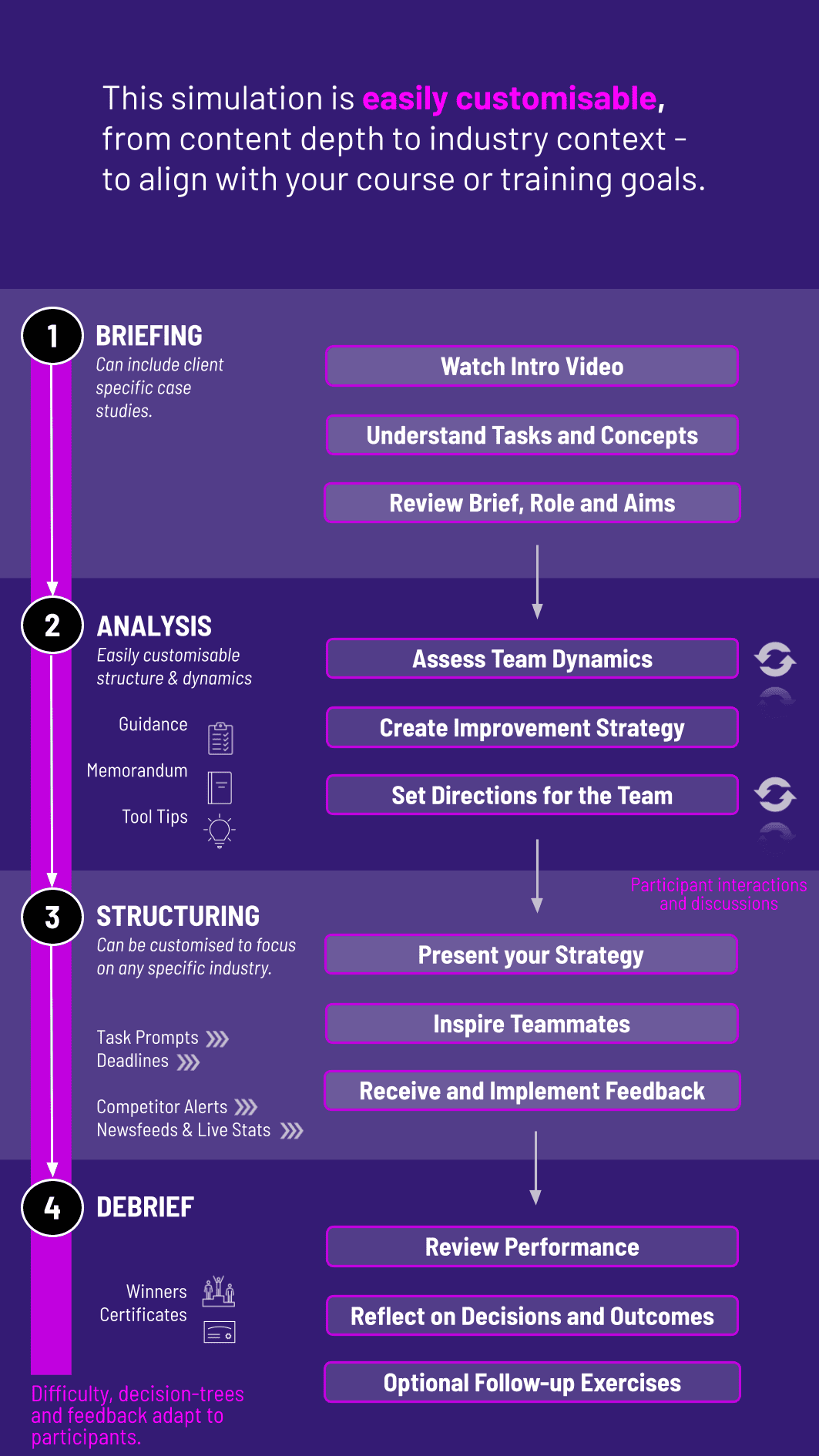
In this Leadership Simulation, participants step into senior roles managing teams through challenges - balancing vision, communication, and decision-making while motivating people, resolving conflicts, and driving organizational performance.
Vision and strategy communication
Motivating teams and individuals
Conflict resolution and negotiation
Leading under uncertainty and crisis
Building trust and credibility
Inclusive leadership and team culture
Stakeholder alignment and influence
Decision-making under pressure
Balancing short-term execution with long-term vision
Self-awareness and adaptive leadership styles


Review scenarios with strategic, cultural, and human elements
Make decisions impacting people, performance, and long-term direction
Handle conflicts, crises, and communication under pressure
Motivate and inspire teams through vision and clarity
Engage with peers, boards, or external stakeholders
Reflect on successes, missteps, and leadership style
By the end of the simulation, participants will be able to:
Communicate vision and strategy effectively
Motivate individuals and teams under pressure
Resolve conflicts constructively and empathetically
Lead through crisis with clarity and confidence
Balance task execution with people management
Build trust and credibility as a leader
Adapt leadership style to context and culture
Manage stakeholder relationships and influence outcomes
Anticipate challenges in organizational change
Develop self-awareness and resilience in leadership roles
The simulation’s flexible structure ensures that these objectives can be calibrated to match the depth, duration, and focus areas of each program, whether in higher education or corporate learning.
The simulation can be run individually or in teams, in classrooms or professional programs. Each cycle represents a leadership challenge.
1. Receive a Scenario or Brief: Participants are introduced to a leadership challenge - such as motivating a struggling team, handling conflict, or steering strategy.
2. Analyse the Situation: They assess cultural, strategic, and human factors affecting their leadership approach.
3. Make Strategic Decisions: Participants decide how to act, balancing empathy with execution.
4. Collaborate Across Roles: Teams may role-play as leaders, employees, or stakeholders to surface different perspectives.
5. Communicate Outcomes: Participants present their choices through speeches, memos, or stakeholder updates.
6. Review and Reflect: Feedback highlights effectiveness of leadership choices and their impact on performance and morale.
Do participants need prior leadership experience? No. The simulation is designed for emerging and experienced leaders alike.
What roles are included? Executives, managers, and team leads in realistic business contexts.
Can it be customized? Yes. Scenarios can reflect different industries, leadership levels, and organizational challenges.
Does it cover crisis leadership? Yes. Crisis management is a key part of the simulation.
Is teamwork required? Yes. Many scenarios rely on collaboration and influence.
How long does it run? It can be delivered as a 2-hour session, a multi-day workshop, or a module in a longer program.
Can it be used in executive programs? Absolutely. It’s highly relevant for both senior managers and executives.
Does it include feedback? Yes. Participants receive structured feedback and opportunities to reflect.
Is it available online? Yes. It works in-person, online, or hybrid formats.
How is performance measured? By leadership effectiveness, decision-making, and communication rather than financial results.
Effectiveness in motivating and guiding teams
Clarity and persuasiveness in communication
Conflict resolution skills and stakeholder alignment
Adaptability in leading under uncertainty
Reflection on personal leadership style
You can also include memo writing and debrief presentations as part of the assessment structure. Additionally, you can also add a built-in peer and self-assessment tool to see how participants rate themselves. This flexibility allows the simulation to be easily integrated by professors as graded courses at universities and by HR at assessment centres at companies.
Join this 20-minute webinar, followed by a Q&A session, to immerse yourself in the simulation.
or
Book a 15-minute Zoom demo with one of our experts to explore how the simulation can benefit you.